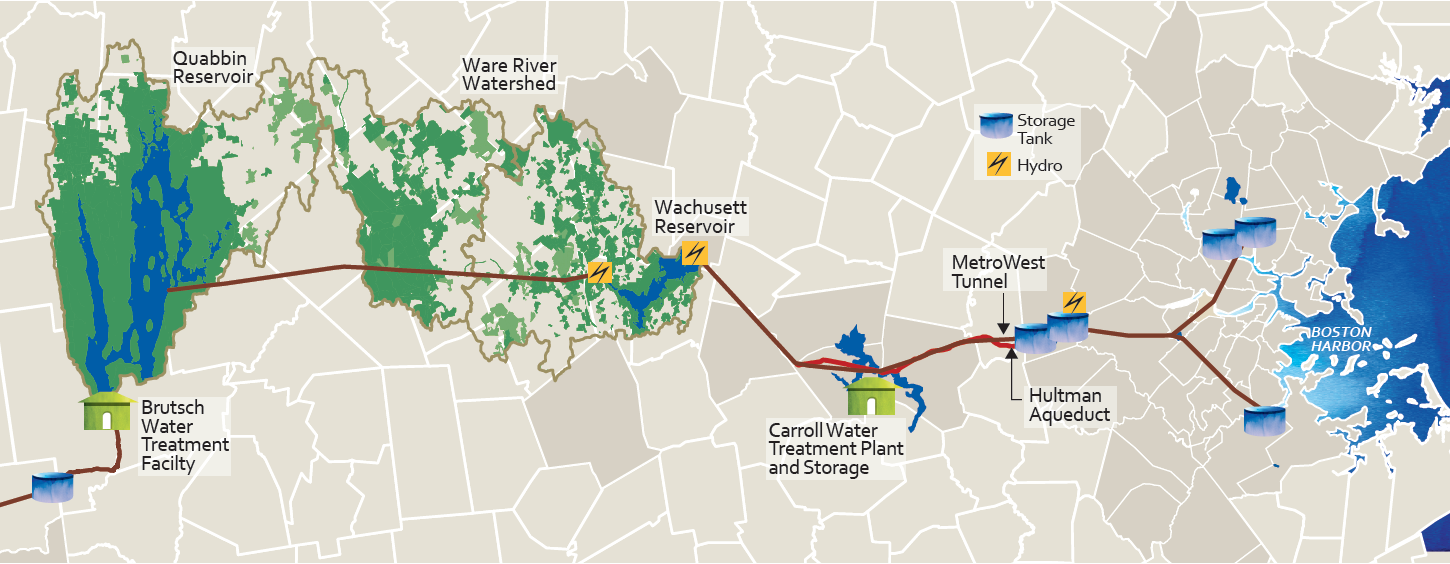| Home |
| About MWRA |
| Water System |
| Sewer System |
| Harbor and Bay |
| School Program |
| Doing Business with MWRA |
| Contact MWRA |
|
WHERE YOUR WATER COMES FROM
MWRA supplies wholesale water services to 53 customer communities.
HOW WATER GETS TO YOUR TAP
Protected Reservoirs
MWRA's water comes from the Quabbin Reservoir, about 65 miles west of Boston, and the Wachusett Reservoir, about 35 miles west of Boston. The two reservoirs combined supply an average of approximately 200 million gallons per day to consumers.The Quabbin alone can hold a supply of five-year supply of water.
The reservoirs are filled naturally. Rain and snow fall onto watersheds (protected land around reservoirs) and eventually turn into streams that flow into reservoirs. This water comes into contact with soil, rock, plants and other material as it follows its path. This process helps to clean the water, and it can also dissolve and carry very small amounts of material into the reservoir.
The Quabbin and Wachusett Reservoirs are protected. Over 85% of the watershed lands that surround the reservoirs are covered in forest and wetlands. About 75% of the total watershed land cannot be built on. The natural undeveloped watersheds help to keep MWRA water clean and clear. Also, to ensure safety, the streams and the reservoirs are tested often and patrolled daily by the Massachusetts Department of Conservation and Recreation (DCR). Because they are well-protected, the water in the Quabbin and Wachusett Reservoirs is considered to be of very high quality.
More information: Massachusetts Water Supply Protection Trust (MA DCR)
Generating Power as it Goes
Quabbin water enters the Wachusett Reservoir at Oakdale and circulates for eight months before being drawn off in Clinton. Electric power is generated as the water both enters and leaves the reservoirs.
Tested Each Step of the Way
MWRA tests over 1,600 water samples per month, from the reservoirs all the way to household taps. Annual and monthly test results are posted on mwra.com.
Treatment
MWRA's licensed treatment operators treat drinking water according to strict state and federal regulations.
|
|||||||||||||||||||||||||||||||||
|
||||||||||
Toward Your Community
For MetroWest and Metro Boston Communities - treated water is sent through the MetroWest Water Supply Tunnel and the Hultman Aqueduct and is stored in covered tanks. From there it is drawn into distribution mains and many smaller community pipes. Water meters log the water entering each community.
Chicopee Valley Area Communities - treated water is sent through the Chicopee Valley Aqueduct to local distribution mains and smaller community pipes. Water meters log the water entering each community.
Into Your Home
Local pipes serve each street and eventually carry water into buildings. Meters installed by the local community measure the amount of water delivered to each home or business.
Updated March 29, 2023
